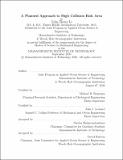| dc.contributor.advisor | Michael R. Benjamin and John J. Leonard. | en_US |
| dc.contributor.author | Li, John Zhang. | en_US |
| dc.contributor.other | Joint Program in Oceanography/Applied Ocean Science and Engineering. | en_US |
| dc.contributor.other | Massachusetts Institute of Technology. Department of Mechanical Engineering. | en_US |
| dc.contributor.other | Woods Hole Oceanographic Institution. | en_US |
| dc.date.accessioned | 2021-01-05T23:14:06Z | |
| dc.date.available | 2021-01-05T23:14:06Z | |
| dc.date.copyright | 2020 | en_US |
| dc.date.issued | 2020 | en_US |
| dc.identifier.uri | https://hdl.handle.net/1721.1/129029 | |
| dc.description | Thesis: S.M., Joint Program in Oceanography/Applied Ocean Science and Engineering (Massachusetts Institute of Technology, Department of Mechanical Engineering; and the Woods Hole Oceanographic Institution), September, 2020 | en_US |
| dc.description | Cataloged from student-submitted PDF version of thesis. | en_US |
| dc.description | Includes bibliographical references (pages 103-107). | en_US |
| dc.description.abstract | This thesis examines the transition of a vessel from the open ocean, where collisions are rare, to a high risk and heavy traffic area such as a Traffic Separation Scheme (TSS). Previous autonomy approaches generally view path planning and collision avoidance as two separate functions, i.e. a vessel will follow the planned path until conditions are met for collision avoidance algorithms to take over. Here an intermediate phase is proposed with the goal of adjusting the time of arrival to a high vessel density area so that the risk of collision is reduced. A general algorithm that calculates maximum future traffic density for all choices in the speed domain is proposed and implemented as a MOOS-IvP behavior. This behavior gives the vessel awareness of future collision risks and aids the collision avoidance process. This new approach improves the safety of the vessel by reducing the number of risky encounters that will likely require the vessel to maneuver for safety. | en_US |
| dc.description.statementofresponsibility | by John Zhang Li. | en_US |
| dc.format.extent | 107 pages | en_US |
| dc.language.iso | eng | en_US |
| dc.publisher | Massachusetts Institute of Technology | en_US |
| dc.rights | MIT theses may be protected by copyright. Please reuse MIT thesis content according to the MIT Libraries Permissions Policy, which is available through the URL provided. | en_US |
| dc.rights.uri | http://dspace.mit.edu/handle/1721.1/7582 | en_US |
| dc.subject | Joint Program in Oceanography/Applied Ocean Science and Engineering. | en_US |
| dc.subject | Mechanical Engineering. | en_US |
| dc.subject | Woods Hole Oceanographic Institution. | en_US |
| dc.title | A planned approach to high collision risk area | en_US |
| dc.type | Thesis | en_US |
| dc.description.degree | S.M. | en_US |
| dc.contributor.department | Joint Program in Oceanography/Applied Ocean Science and Engineering | en_US |
| dc.contributor.department | Massachusetts Institute of Technology. Department of Mechanical Engineering | en_US |
| dc.contributor.department | Woods Hole Oceanographic Institution | en_US |
| dc.identifier.oclc | 1227044247 | en_US |
| dc.description.collection | S.M. Joint Program in Oceanography/Applied Ocean Science and Engineering (Massachusetts Institute of Technology, Department of Mechanical Engineering; and the Woods Hole Oceanographic Institution) | en_US |
| dspace.imported | 2021-01-05T23:14:05Z | en_US |
| mit.thesis.degree | Master | en_US |
| mit.thesis.department | MechE | en_US |
